
Cuscuta, commonly known as dodder or amarbel, is a genus of over 201 species of yellow, orange, or red parasitic plants. Formerly treated as the only genus in the family Cuscutaceae, it now is accepted as belonging in the morning glory family, Convolvulaceae, on the basis of the work of the Angiosperm Phylogeny Group. The genus is found throughout the temperate and tropical regions of the world, with the greatest species diversity in subtropical and tropical regions; the genus becomes rare in cool temperate climates, with only four species native to northern Europe.

Onopordum, or cottonthistle, is a genus of plants in the tribe Cardueae within the family Asteraceae. They are native to southern Europe, northern Africa, the Canary Islands, the Caucasus, and southwest and central Asia. They grow on disturbed land, roadsides, arable land and pastures.

The genus Carthamus, the distaff thistles, includes plants in the family Asteraceae. The group is native to Europe, North Africa, and parts of Asia. The flower has been used since ancient times in the Philippines, which it has been called kasubha by the Tagalog people.
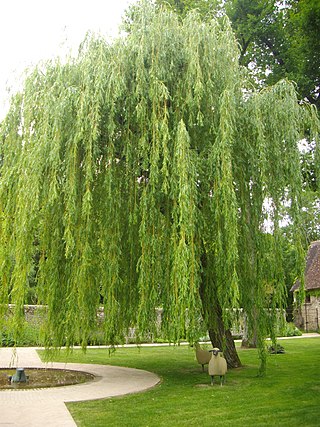
Salix babylonica is a species of willow native to dry areas of northern China, but cultivated for millennia elsewhere in Asia, being traded along the Silk Road to southwest Asia and Europe.

Pierre Edmond Boissier was a Swiss prominent botanist, explorer and mathematician. He was the son of Jacques Boissier (1784-1857) and Caroline Butini (1786-1836), daughter of Pierre Butini (1759-1838) a well-known physician and naturalist from Geneva. With his sister, Valérie Boissier (1813-1894), he received a strict education with lessons delivered in Italian and Latin. Edmond's interest in natural history stemmed from holidays in the company of his mother and his grandfather, Pierre Butini at Valeyres-sous-Rances. His hikes in the Jura and the Alps laid the foundation of his zest for later exploration and adventure. He attended a course at the Academy of Geneva given by Augustin Pyramus de Candolle.

Cuscuta californica is a species of dodder known by the common names chaparral dodder and California dodder. This is an annual parasitic plant that may resemble fine strands of spaghetti or twine strewn across other species in its habitat. A mature plant of this species may fulfill all of its food and water needs from the host plant, but they rarely kill their host. It is native to western United States and Baja California in Mexico.
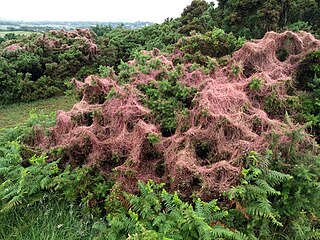
Cuscuta epithymum is a parasitic plant assigned to the family Cuscutaceae or Convolvulaceae, depending on the taxonomy. It is red-pigmented, not being photosynthetically active. It has a filiform habit, like a group of yarns. Its leaves are very small, like flakes. Its flowers, disposed in little glomerules, have a white corolla, with the androecium welded to the corolla.

Cuscuta approximata is a species of dodder known by the common name alfalfa dodder. It is native to Eurasia and Africa, but it is also found in North America, where it is an introduced species and uncommon noxious weed. It is a parasitic vine which climbs other plants and takes nutrition directly from them via a haustorium. The dodder resembles a pile of light yellow to orange-red straw wrapped tightly around its host plant. It is mostly stem; the leaves are reduced to scales on the stem's surface, since they are not needed for photosynthesis while the dodder is obtaining nutrients from its host. It bears clusters of tiny yellowish bell-shaped flowers which are only about 3 millimeters wide. The dodder reproduces by seed, with each plant capable of producing over 10,000 seeds at once. This plant is a weed of alfalfa, clover, and tomatoes, as well as other crop plants and native flora. This species is sometimes treated as a subspecies of Cuscuta epithymum.

Senecio vernalis is one of the European species of Senecio, an annual that is also known as eastern groundsel. While it has been long classified as Senecio vernalis, this species has more recently been described as a subspecies of Senecio leucanthemifolius and is now included by some in that species.

Senecio glaucus is an annual member of the Asteraceae and species of the genus Senecio. It is found from the western Mediterranean to Central Asia in sandy, well-drained soil, particularly coastal and desert dunes.
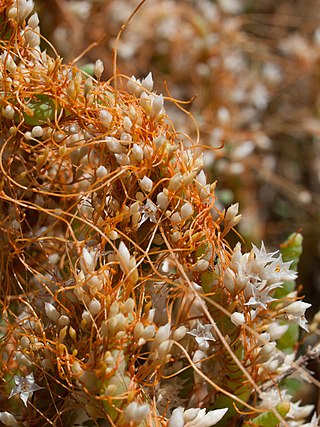
Cuscuta salina is a species of dodder known by the English name salt marsh dodder and is a native plant of western North America. The habitat includes coastal tidal wetlands in California, as well as saline habitats away from the coast, such as vernal pools and salt flats. Salt Marsh Dodder is a parasitic plant, wrapping orange-colored stems around natural wetland vegetation and absorbing nutrients of host plants via their specialized structures called haustoria.

Halothamnus glaucus is a species of the plant genus Halothamnus, that belongs to the subfamily Salsoloideae of the family Amaranthaceae,. It occurs in Western and Central Asia.
Ammochloa is a genus of Mediterranean plants in the grass family, Poaceae.
Crithopsis is a genus of plants in the grass family, native to the Mediterranean and nearby areas.

Carduncellus is a genus of flowering plants in the tribe Cardueae within the family Asteraceae. They are native to the western Mediterranean and surrounding regions.
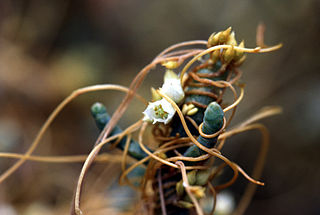
Cuscuta pacifica is a species of dodder. Its common name is goldenthread.

The flora of Lebanon includes approximately 2,600 plant species. Situated on the eastern coast of the Mediterranean Basin, Lebanon is a reservoir of plant diversity and one of the world's biodiversity hotspots for conservation priorities. Endemic species constitute 12% of the Lebanese flora; 221 plant species are broad endemics and 90 are narrow endemics. Important Plant Areas (IPAs) featuring the country exceptional botanical richness were defined in 2018.
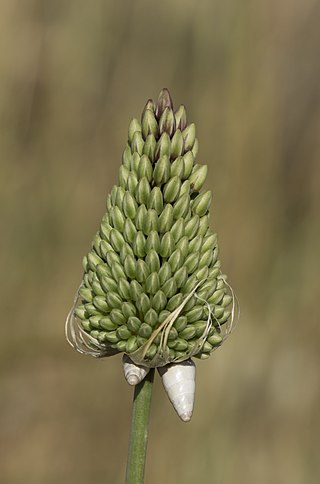
Allium curtum is species of flowering plant in the amaryllis family, Amaryllidaceae. It is native to Cyprus, Egypt, Lebanon, Palestine, the Sinai Peninsula, Syria and Turkey. It is a bulb-forming perennial producing a tight, head-like umbel of green or purple flowers.
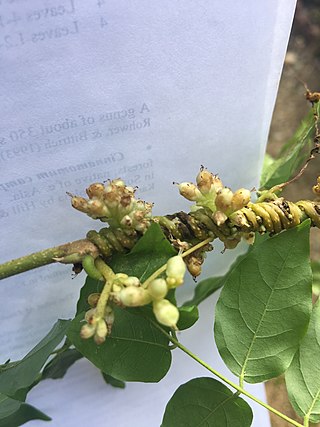
Cuscuta compacta, the compact dodder, is a parasitic plant that specializes on woody plants. This species is distributed across the Eastern and Midwestern USA, Eastern Canada, and Mexico.
Cuscuta babylonica is a species of parasitic plants in the morning glory family, Convolvulaceae. It is found in Iraq and Turkmenistan.

















